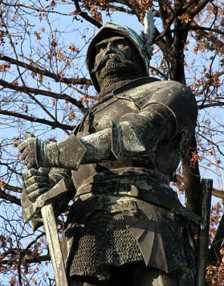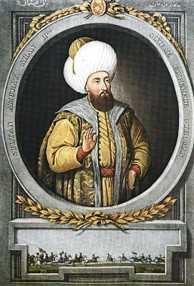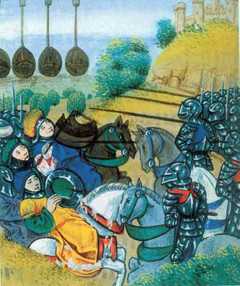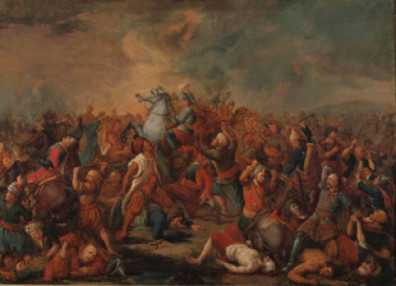The Last Offensive: The Battle of Kosovo (18–19 October 1448)
Szöveg: hungariandefence.com | 2011. október 18. 7:36The battle of Kosovo took place 563 years ago, on 18-19 October 1448. It was a fight between the Ottoman army led by Sultan Murad II and the Christian armies led by Hungarian Governor János Hunyadi, and ended in defeat for the Hungarians. This defeat was one of Hunyadi’s greatest failures during his campaign against the Ottoman Empire. We commemorate the historic event by excerpting from the book “For the Homeland Unto Death – 1100 years” published by Zrínyi Média, which is available in our Digital Library.

King Wladislas I precluded the immediate
continuation of the offensive strategy against
the Ottomans. But Commander John Hunyadi
did not lose his conviction. He waited for the
situation to consolidate so that he could again
try to force the enemy to its knees on its own
territory.
Hunyadi returned from the battle of Varna as
the most pre-eminent figure in the kingdom, and
one of the wealthiest. The Diet of 1445 elected
him as one of seven governors responsible for
maintaining order, but in Transylvania and the
surrounding counties he was already all-powerful.
In autumn 1445, in alliance with the Prince of
Wallachia, and with the support of Burgundian
ships, he led a lightning campaign against
the Lower Danube, where he unsuccessfully
besieged the castle of Little Nicopolis. Then
he led his army against the Cilli counts who
were occupying Slavonia (April-May 1446), and
then in late autumn 1446, by then Regent, tried
to force King Frederick of the Germans to
evacuate the occupied Hungarian lands. Neither
of these operations was militarily successful,
but this only temporarily took the shine off his
military reputation. In 1447, he came to terms
with Frederick, the Cillis and the leader of the
Bohemian force occupying the north-western
parts of the kingdom in the name of Ladislas V,
John Jiskra, thus achieving the internal conditions
for a renewed campaign against the Ottomans.,
John Hunyadi attempted to persuade the
Pope and the European powers to cooperate
with him in 1447, but with little success. It was
only with Alfonso of Aragon, King of Naples,
that he succeeded in agreeing on a specific plan.
Alfonso undertook to pay a hundred thousand
florins to raise 16,000 mercenaries. Hunyadi
promised to raise this number, and use them,
with Wallachian assistance, to expel the Turks
from Europe. Nothing came of the plan, even
though Hunyadi offered Alfonso the Hungarian
crown. He did, however, succeed in renewing the
alliance with George Kastrioti of Albania, who
had resisted Ottoman pressure for many years.
Hunyadi could also depend on the support of
the Voivode of Wallachia, whom he had already
helped by force of arms in taking the throne in
the winter of 1447-48. A serious threat, however,
was the stance of the Serbian despot George
Brankovič, who had been in bitter conflict with
Hunyadi since 1444, and whose hostile actions
could have meant the failure of the entire
campaign.
To finance the campaign, as was customary, a
tax was levied: one golden florin per four plots.
Mercenaries were paid in the same way as in
previous campaigns: the recruiting captains
received the money required to raise the
specified number of soldiers in advance, out of
extraordinary tax and other revenue. Transylvania,
the territory Hunyadi ruled directly, provided
much of the army’s equipment (for example,
his local agents purchased the horseshoes, nails,
screws etc. in the required quantities), but he
also received assistance from other towns. He
requested above all the manufacture of carts
and cannon, including mortars. All this filled an
alleged total of two thousand carts.

learned at the Varna catastrophe. Although the
aims of the campaign again included mobilisation
of the Balkan peoples, Hunyadi fitted out a large
number of infantry against every eventuality. A
contemporary source puts their number at six
thousand. The light equipment of the infantry
(hand shield, bow, sword) suggests that they were
to have an attacking function in battle. Defence
was to be provided by the wagons themselves
and the small-calibre guns (cerbottana) mounted
on them. The gun-carrying wagons and the
infantry were also to provide defence in transit,
particularly at river crossings. Nonetheless, the
backbone of the army remained the armoured
cavalry, which must have numbered some 15,000.
Supplementing these were some 8000 light
cavalry, mostly from Wallachia. The total strength
of the army was thus around 30,000, and not
only was it larger than four years previously, it
had a structure better favoured to an attacking
campaign. As in 1444, however, its success still
depended on surprise and the assistance of the
Balkan people.
We know little of the battle plan. Hunyadi’s
declared objective was to unite with the Albanian
forces of Skanderbeg and then proceed together
to take Saloniki. That is why, after initially
following the same route as in 1443, he turned
west at Niš and then south, and in the Toplica
valley he marched towards Kosovo Polje.
Some sources claim the Serbian despot George
Brankovič, whom Hunyadi had abandoned in
1444, betrayed his plan to Sultan Murad, and so
surprise was lost. In fact the Sultan had known
of Hunyadi’s preparations since midsummer and
had ample time to prepare for whatever action
the Hungarian army took. It would in any case
hardly have been possible to keep secret from
his scouts the movements
of a 30,000-strong army.
He gathered his forces
in Sofia, from where he
could intervene anywhere
necessary. Murad could
mobilise his entire army,
and so it is hard to imagine
what kind of surprise
Hunyadi could have been
thinking about. Although
the Hungarian commander
knew that the Sultan was
making preparations in Sofia,
he left his rear uncovered,
for which there can be only
one explanation: he seriously
underestimated the strength
of the Ottoman army, and
still believed that by uniting
with his Balkan allies he
could break them in a single
battle. It was no doubt this
tragic error that influenced
Aeneas Silvius Piccolomini,
who was hostile to Hunyadi but genuinely
supported the war against the Ottomans, when he
stated that Hunyadi “considered himself to stand
apart from everyone else, and had contempt for
his enemies as if they were women." It is true that
he had not been able to engage the Ottoman army
in a regular battle on terms of his own choosing
either in the long campaign, owing to the Sultan’s
retreat, or at Varna, owing to the failure of the
Christian fleet and then the unexpected death of
the King, and so his strategy based on a decisive
battle may have seemed well-grounded – until 18
October.
The Hungarian army left its camp beside the
Danube on 28 September, and two weeks later
was on the northern edge of the Kosovo Polje
plateau. Since the Sultan’s army appeared at
the same place one or two days later, but at the
Christians’ backs, this meant that Murad left Sofia
before being informed of Hunyadi’s change of
direction. In other words, there could have been
no question of surprise on the Ottoman side: they
executed just as purposeful a military manoeuvre
as they had in 1444, and forced the Hungarian
army into a similarly restricted situation as at
Varna. It is also possible that the Sultan lured
Hunyadi into a trap on the Kosovo Polje plateau.
According to a contemporary source, “although
he knew he was the stronger, he feigned retreat."
Which means that, as in 1443, he sent several
small contingents against the Christian army,
luring them south by successive retreats, while the
main Turkish army came behind them. However
it happened, after the Turkish army appeared,
Hunyadi, as in 1444, was forced to face it in
battle. He could have made a forced march south
to unite with the Albanians, but in that case he
would have had to make up for losses where he
was, and if defeated would have put Hungary
utterly at the mercy of the Ottomans.

about 40 km long and 14-17 km wide surrounded
by 800-1000-metre-high gently-rising hills. The
River Sitnica meanders across the plateau, and
several streams from the surrounding hills –
including the Lab in the north – flow into it.
Kosovo Polje was at the intersection of the
main transport routes through the West Balkans,
and its medieval principal town was Pristina,
once a Serbian royal seat. The plateau is not
completely flat, but divided by hills of different
sizes, separated by small expanses of marshland.
The largest of these lay on the northern part
of Kosovo Polje, along the lower stretch of the
Lab. To the south-east, the marsh is bounded by
a ridge on whose eastern edge lay the grave of
Murad I, who died in the first Battle of Kosovo in
1389. This, almost right in the valley of the river,
is where Hunyadi was in camp when he heard
of the arrival of the Sultan. The Ottoman army
was advancing along on the road out of the Lab
valley from Pristina, a few kilometres to the east
of Murad’s grave, and threatening to occupy the
strategically-important hill. Hunyadi sensed the
danger and took the hill with his cavalry in a hard
struggle. He set up the wagon fort on the hill and
placed the army around it, clearly in attacking
formation. The hill was taken and the camp set
up on 17 October. The Hungarian army was thus
separated from its water supply, but a cavalry
charge launched downhill seemed to promise
success. The Turkish army took up a position
on the north of the marsh, at the Hungarians’
previous place, beside the Lab stream.
There can be no doubt that the Ottoman army
had a considerable numerical advantage. We know
from Turkish sources that the Sultan mobilised
the Janissaries, the mercenary cavalry, the Asian
and European cavalry, the Akinjis and the Azaps,
and even brought nomadic Tartars in support.
One Turkish historian puts the number of Azaps
alone at ten thousand; there must have been as
many Akinjis and a minimum of six thousand
Janissaries and Porte mercenaries, so that taken
together with the Anatolian and Rumelian
cavalry and the mobilised Balkan garrisons, the
Ottoman army must have had a total strength
of at least fifty thousand. Murad arranged this
strength in the traditional configuration. In the
centre were the Janissaries and the Azap infantry,
and in front of them the artillery dugouts. The
Anatolian cavalry was on one wing and the
Rumelian cavalry and the Akinjis on the other.
At the rear, the army was defended by a camp
fort assembled from baggage. The Sultan had
armed the equerries, camel-drivers and other
auxiliary personnel in the camp, and set a few
thousand regular troops alongside them.
The formation of the Hungarian army which
faced them is not clear. Its centre must have been
occupied by Hunyadi’s armoured horsemen,
with the offensive infantry behind them, in
front of the wagon fort. The barons’ militias,
which later fell in the battle, were probably
also placed in the centre. On the wings were
assorted cavalry, the light horsemen in front,
including the Wallachian auxiliaries, and behind
them the armoured cavalry. There is no reliable
information as to which officers were leading the
wings. What is certain is that there were several
barons with substantial combat experience and
thus equal to the task, such as Hunyadi’s brotherin-
law János Székely of Szentgyörgy, the former
Ban Frank Tallóci, Imre Marcali and Imre Bebek.
Hunyadi reinforced the wagon fort in the same
way as the Sultan: the wagons were fastened to
each other by chains, and some of the guns were
set on the wagons and others between them, on
the ground. The enormous wagon fort had to
serve as a refuge for the entire retreating army
if necessary.

was preceded by a curious scene. Since he heard
the story from Count Ulrich of Cilli, who had
got it from his father-in-law the Serbian despot
George Branković, it cannot be regarded as pure
guesswork. The story is that before the battle,
eight prominent Turks appeared in the Christians’
camp and “appalled at the shedding of human
blood" offered peace and a hundred thousand
florins in tribute. If this was true, it was clearly
the customary trick of oriental warfare, with the
purpose of making the enemy over-confident.
The battle began on 18 October. It is probable
that the Hungarian left and right wings swept
into attack simultaneously, and the Anatolian and
Rumelian corps drew back, but according to plan,
and not in confusion. There was no panic-like
retreat: the Turkish historians talked of “defeat"
only so as to magnify the later victory. According
to a later source, the Turks then employed the
same kind of encircling manoeuvre as they
had at the Battle of Varna. The same Turkhan
Bey as had led the Akinjis in 1443 came on the
rear of the Hungarian left wing, together with
the Anatolian cavalry, who had turned round.
The Christian forces, including the Wallachians,
were caught in the pincers and destroyed. It is
also possible that the latter surrendered without
serious resistance. The sources are utterly silent
about the cavalry on the right wing. It is probable
that they crumbled in the fight with the Rumelian
cavalry after their turn, and the remnants were
unable to interfere effectively in the course of
the battle after the centre was destroyed.
Seeing the apparent success of the cavalry
charge on the wings, Hunyadi launched an attack
with his armoured cavalry, what the Turkish
chroniclers mentioned as the “iron wall", the
lightly-armed attack infantry behind them,
against the Azaps and Janissaries in the centre.
The Turks attempted to interrupt the charge with
burning camels and a hail of arrows, and then in
a well-disciplined manoeuvre, separated to open
up a passage for the Christian cavalry. The charge
was impeded by the reinforced camp of baggage
and wagons, and the Turkish infantry came from
behind on the confused cavalry, slaughtering
the horses on their unarmoured, rear ends. The
arrested ranks were further pressed by those
coming behind them, and they stamped each
other down. Some of the horsemen, deprived of
their horses, broke their way through and sought
refuge in a nearby village, whose houses the
Turks set fire to. The enormous losses suffered
in the centre are indicated by the list of fallen
barons: Imre and László Bebek, Imre Marcali,
Frank Tallóci, Tamács Szécsi, Benedek Losonci,
István Bánfi of Alsólindva and their banderia, a
great many unknown soldiers, all lost their lives
on the field.
Turkish historians claim he forced his way
back to the wagon fort, others that he escaped
towards Serbia. The latter version is supported
by the fact that the Regent was taken into
captivity by Branković, and in any case he would
hardly have been able to make his way north
from the wagon fort through the victorious
Turkish army next day.
It is not clear whether the Christian infantry
advancing in the wake of the cavalry charge also
penetrated the gap which opened up, or clashed
with the wall of the Turkish infantry after it
closed. All that is certain is that grim hand-tohand
fighting ensued and continued until dusk.
Then the remaining infantry retreated to the
wagon fort and waited for the Turkish charge
under cover of the wagon-mounted cannon. It is
not impossible that a small section of the cavalry
also managed to fight its way back to the fortified
camp, but it is pure historians’ fiction that the
Hungarians’ standard still flew on the evening
of 18 October and the Sultan only managed
to overcome them next day after deploying
fresh troops. None of the sources mention the
involvement of Hungarian cavalry in the fight
that began on 19 October.
The battle was lost, just as it was 78 years later at
Mohács, in the failure of the cavalry charge: the
infantry, deprived of their cavalry support, had
no chance of breaking through the Turkish army.
According to Hunyadi’s report, they fired at each
other all night with “machines", but it is clear
from the events of the previous day that this was
no longer the artillery duel of two equal forces.
There can be no question of Hunyadi leading
his cavalry from the wagon fort in a night assault
against the Janissaries. This was worked into
the account of a later Greek historian Laonikos
Chalkokondylas, and passed from there into
Hungarian military history. The truth is illustrated
by one Turkish account. The Turkish infantry,
under the cover of the night, approached within
one arrow’s range of the Christians’ wagon fort,
and from there fired on them with cannon and
handguns, fire which was returned from the
wagon-mounted cannon. The objective of the
artillery fire was not so much to cause losses as
to prevent the defenders from resting, something
also alluded to in a comment by Hunyadi. On
the dawn of 9 October, the Turks launched the
final charge from such close range that the wagon
fort defenders could not make good use of their
guns. The Ottomans broke in to the wagon fort
with lances and swords and in a gory slaughter
ground down the resistance. The “Germans and
Bohemians", i.e. the infantry, were killed to a man.
The Ottoman victory is usually described as
being very bloody, but the tens of thousands
of dead which the Western chronicles recorded
belong to the world of legend. Many of the
Janissaries must have fallen in the grim close
combat, and there must also have been significant
losses among the Spahis, but the number of dead
could not have been more than ten thousand. The
losses among the Hungarian army are similarly
difficult to estimate. The greatest losses were
suffered by the infantry and the cavalry which
charged in the centre. That was where the barons
and probably a large part of the horsemen serving
in the militias fell. There were probably fewer
casualties on the wings, where the engagement
lasted a shorter time and there were greater
chances of escape. Taken together, a number
of eight to ten thousand casualties seems like a
sound estimate. A great many were taken prisoner
as they fled: Sebestyén Rozgonyi, for example,
was ransomed years later, from the Genovese.

taken by Branković’s men to Szendrő (Smederevo,
Serbia). The despot had good reason to be angry
with Hunyadi, and his time for revenge had come.
He permitted Hunyadi to establish contact with
Hungary’s governing barons who, upon hearing
of the Regent’s escape and captivity gathered
in Szeged and started negotiations with the
despot. Branković set very hard terms: Hunyadi
had to return the despot’s estates in Hungary,
engage his younger son Matthias to Branković’s
granddaughter Elizabeth Cilli, and leave his elder
son Ladislas in Smederevo. After satisfying these
terms, Hunyadi was allowed to leave the despot’s
court in December. Hunyadi naturally had no
intention whatever of keeping to the agreement,
but in his weakened political position following
the lost battle, neither could he think about
revenge.
The defeat at the Battle of Kosovo finally
proved that the Hungarian tactics based on a
decisive armoured cavalry charge were ineffective
against disciplined Janissaries who could open up
a gap, and the large number of Turkish cavalry
capable of similar tactics. Against such an
army, only a much larger, trained infantry, kept
permanently under arms, and a light cavalry of
similar size could have engaged the Ottomans
with any chance of victory. Such an army
would demand similar financial resources as the
Ottoman Empire had, and Hunyadi’s Hungary
was not in that class. For that reason, Hunyadi’s
concept of the decisive battle would not have
been viable even if the Hungarian army had by
some stroke of fortune succeeded in defeating
the Ottoman army in open battle. For the
Sultan, as is well illustrated by the example of
Nándorfehérvár, the destruction of almost his
entire infantry and the severe loss of his cavalry
was not an impediment to him replenishing his
army to a force of equal combat effectiveness
within a few years. After 1448, no Hungarian
military leadership ever attempted to break the
Ottoman Empire by a single decisive battle on its
own territory.
Excerpt from Tamás Pálosfalvi “Nikápolytól Mohácsig
1396–1526" (From Nicopolis to Mohács 1396-1526. Zrínyi
Kiadó, Budapest, 2005)